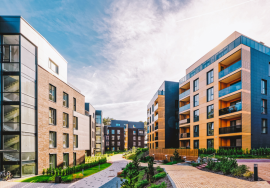How Building Technologies Are Making Homes More Sustainable
How Building Technologies Are Making Homes More Sustainable

As the world becomes increasingly conscious of environmental issues, building technologies are playing a crucial role in creating more sustainable homes. These advancements not only help reduce a home’s environmental impact but also improve energy efficiency and reduce utility costs. This blog explores how modern building technologies are making homes more sustainable, highlighting key innovations and their benefits.
Understanding Sustainable Building Technologies
1. Definition and Scope: Sustainable building technologies are designed to minimize the environmental impact of homes while enhancing their efficiency and comfort. These technologies encompass a wide range of solutions, including energy-efficient systems, eco-friendly materials, and innovative design practices aimed at reducing a home’s carbon footprint.
2. Key Areas of Focus:
- Energy Efficiency: Technologies that reduce energy consumption and improve overall efficiency.
- Water Conservation: Solutions that minimize water usage and waste.
- Eco-Friendly Materials: Use of sustainable and recyclable materials in construction.

Key Technologies Enhancing Home Sustainability
1. Energy-Efficient Systems: Energy-efficient systems are fundamental to sustainable homes. These include:
- Smart Thermostats: Devices like Nest or Ecobee adjust heating and cooling based on occupancy and weather, optimizing energy use and reducing costs.
- High-Efficiency HVAC Systems: Modern heating, ventilation, and air conditioning (HVAC) systems are designed to use less energy while maintaining optimal comfort.
- LED Lighting: LED bulbs consume significantly less energy than traditional incandescent bulbs and have a longer lifespan, contributing to lower energy consumption.
2. Renewable Energy Sources: Integrating renewable energy sources into home design is a key strategy for sustainability. Popular options include:
- Solar Panels: Solar photovoltaic panels convert sunlight into electricity, reducing reliance on fossil fuels and lowering energy bills.
- Solar Water Heaters: These systems use solar energy to heat water, reducing the need for conventional water heating methods.
- Wind Turbines: Small residential wind turbines can generate electricity, particularly in areas with consistent wind patterns.
3. Water Conservation Technologies: Water-saving technologies help reduce water usage and promote efficient resource management. Examples include:
- Low-Flow Fixtures: Low-flow toilets, faucets, and showerheads reduce water consumption without sacrificing performance.
- Rainwater Harvesting Systems: These systems collect and store rainwater for use in irrigation and other non-potable applications.
- Greywater Recycling: Greywater systems reuse water from sinks, showers, and washing machines for irrigation or flushing toilets.
4. Eco-Friendly Building Materials: Using sustainable materials in construction can significantly reduce a home’s environmental impact. Key materials include:
- Recycled Materials: Products made from recycled content, such as recycled steel or reclaimed wood, reduce the need for virgin resources.
- Sustainable Lumber: Wood certified by organizations like the Forest Stewardship Council (FSC) ensures responsible forestry practices.
- Green Insulation: Insulation made from natural or recycled materials, such as cellulose or cork, improves energy efficiency and reduces the use of synthetic products.
5. Smart Home Technologies: Smart home technologies enhance sustainability by providing better control over energy use and home systems. Examples include:
- Home Automation Systems: These systems allow homeowners to control lighting, heating, cooling, and appliances remotely, optimizing energy use and reducing waste.
- Energy Monitoring Tools: Devices that track and analyze energy consumption help identify areas for improvement and promote more efficient usage.
Benefits of Sustainable Building Technologies
1. Reduced Environmental Impact: Sustainable building technologies contribute to environmental conservation by reducing energy consumption, minimizing waste, and decreasing greenhouse gas emissions. This helps combat climate change and preserves natural resources.
2. Lower Utility Costs: By improving energy and water efficiency, sustainable technologies lower utility bills for homeowners. Investments in renewable energy sources and energy-efficient systems can lead to significant long-term savings.
3. Enhanced Comfort and Health: Many sustainable technologies improve indoor air quality and overall comfort. For example, advanced HVAC systems and eco-friendly materials contribute to a healthier living environment and better indoor air quality.
4. Increased Property Value: Homes with sustainable features often have higher market value and appeal to eco-conscious buyers. Incorporating building technologies can enhance a property’s resale value and attract potential buyers.
Conclusion
Building technologies are revolutionizing the way we approach home sustainability, offering innovative solutions to reduce environmental impact, lower utility costs, and enhance overall comfort. By integrating energy-efficient systems, renewable energy sources, water conservation technologies, and eco-friendly materials, homeowners can contribute to a greener future while enjoying the benefits of a more sustainable living environment.
For more information on how building technologies can make your home more sustainable, visit Sustainable Building Technologies and Green Home Innovations. To explore how these technologies can be applied to your project, contact AMS India.
Read more related articles to enhance your knowledge and make informed decisions
10 Essential Steps in the Building Construction Process
How to Choose the Right Materials for Your Construction Project








